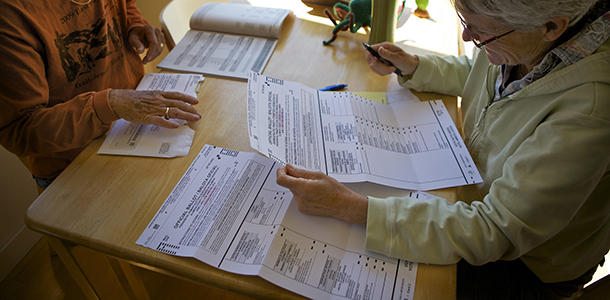
(Photo Credit: Joe Philipson/Flickr)
Thirty percent of California’s registered voters are not affiliated with either major party and that number is growing each year.
Right now, about five percent of registered voters have affiliated with third parties, leaving more than 23 percent who are classified as No Party Preference (NPP). But are those voters truly independent and do they really have no party preference?
“People idealize those who decline to pick a party as somehow having reached a deeply, thoughtful conclusion that’s more respectable than that of partisans,” said Dr. Raphael Sonenshein, executive director of the Pat Brown Institute for Public Affairs at CSU Los Angeles. “That’s also completely not true,” he added, “Most of those Decline to State [voters], by the way, lean toward one party or the other.”
Political Consultant Mike Madrid of Grassroots Lab agreed, arguing voters aren’t necessarily moving to the middle but could be unsatisfied with the major parties.
“If you disaffiliate, it could be because you are a 60-year-old white male from the Central Valley that believes the Republican Party is far too liberal, or it could mean that you’re a 22-year-old progressive woman from Santa Monica who thinks the Democratic Party is far too corporate,” said Madrid. “So, there’s no rhyme or reason to what’s happening. It’s just that the two parties really don’t address what is happening in society anymore.”
According to the California Secretary of State’s Odd Numbered Year Report of Registration (PDF) issued earlier this year, the percentage of NPP voters has risen nearly three percent (20.9 percent in 2013 to 23.6 percent in 2015) in the last two years. Meanwhile both major parties and the third parties have lost affiliated voters. Right now, Democrats make up 42.3 percent of the state’s registered voters while Republicans are at 28 percent. And overall, the state’s voter registration declined from 75.7 percent of eligible voters in 2013 to the current rate of 72.7 percent.
This is happening because our society is changing and becoming more fragmented, said Madrid. “People have millions of choices, everything from which TV channels they want to watch, or what radio stations they want to play. The fact that we have two parties you have to choose between to represent your political perspective, it’s a real outmoded concept, a concept of a time that’s past.”
Having nearly a quarter of the voting public NPP means the parties must adjust. “People in leadership positions mostly likely have to take positions on things or do things that show people that they can really make a difference,” suggested Sonenshein. He added that voter registration and election reforms could help engage more voters, “It’s a combination of easing the system so it’s more accessible, but also make the system more clearly make a difference to people.”
For now, the rise of NPP voters is causing political polarization because speaking to their most extreme members may currently be the most effective way for the political parties to campaign.
“There’s no constituency in the middle,” said Madrid, “so you can’t target them that way and most political professionals haven’t figure that out, or I should say, it’s inefficient to spend the time and resources to figure that out, so it’s easier to double down on what you already know.”
But as the percentage of NPP voters grows, and all indications are that it will, campaigns will have to adjust and find non-traditional ways to reach voters.
“Campaigns aren’t going to be using ‘party’ as the only way to target voters,” said Madrid. “There are far better ways to do it, everything from income and education levels to marital status, gender, to the data trails we leave on our social media sites, which is far better data.”
So in the very near future, what you post on your Facebook page or Tweet to your followers may be more important to campaigns than whether you have an “R,””D” or “NPP” next to your name.
But affiliated with a party or not, an engaged and participatory electorate is one half of a vital democracy. The other half is made of responsive and representative elected officials who are accountable for actual results.

